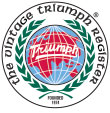Wire Wheel Tightening
(Ooriginally titled Principles of the Rudge-Whitworth Centre-Lock Wire Wheel,
original printing in Issue #31 (1981) of The Vintage Triumph by F. Wilson McComb, submitted by Bill Sohl. Aadditional information added in Issue #51 (1992) of The Vintage Triumph by George Osmandson, and final comments [in brackets] by Art Kelly)
Principles of the Rudge-Whitworth Centre-Lock Wire Wheel
What is equally widely misunderstood however, is the all important bit in the middle of the wheel.
Let us take a closer look at this assembly referring to the central portion of the wheel as the ‘wheel centre’ which is fitted to the ‘hub’ and fixed in place with a ‘locking cap’. The first thing that must be appreciated is that the wheel centre does not come into contact with the brake drum; there is in fact, a clearance of about 1/8″ when the wheel is fully home. [I just checked my wheels to verify this.] It is the back taper of the hub [adaptor on my TR4] that comes into contact with the back taper of the wheel. Notice too, the taper which is formed on the outer surface of the wheel centre. This engages with yet another tapered surface on the inside of the locking cap. When the wheel is fitted to the hub and the locking cap screwed on, it [the wheel] is therefore centralized and held between two pairs of tapers. The only other contact between hub and wheel centre is provided by the splines which carry the driving and braking forces. The locking thread on the hub and cap is right-handed on the left (near) side of the car and left-handed on the right (off) side.
One of the endearing mysteries of the wire wheel is that the spokes are not …. indeed, can never be …. in compression; the weight of the stationary car is suspended from those spokes which are uppermost in the wheel. … As the car moves forward, a different portion of the wheel rim takes the weight and relative movement occurs between wheel centre, locking cap and hub. The effect of this is to tighten the locking cap and the locking action continues until there is firm contact with the tapers all around, when it [the locking action] ceases. The clearances involved are of course, minute but the locking action is completely positive and entirely automatic.
There are people who deny the very existence of this locking action and presumably attribute left and right hand threads to cussedness on the part of the manufacturer. They are, no doubt the ones who bash their locking caps with heavy hammers. [McComb’s words!]
The earliest instructions that I have been able to trace [McComb says elsewhere that it was in the 1918 Autocar Handbook. Yes, 1918!], advise leaving the locking cap finger tight and no more. A later recommendtion is to hammer the locking cap tight, check for slackness after 20 miles and tighten again if necessary.
‘Hammer them tight’ means the application of a lead, copper or hide mallet and a little common sense, with the wheel locked up [read brakes applied or equivalent] … not a murderous attack with a heavy hammer … [McComb then discusses the importance of keeping the surfaces clean and using some oil on the threads so no rust forms – which would freeze everything up.]
The effect of overtightening? We have seen that the wheel is held in place between two pairs of tapers and does not touch the brake drum. Excessive tightening of the locking cap will therefore force the wheel centre farther onto the back taper of the hub, expanding it and thus making …eventually, a sloppy fit on the hub. The outer taper tends to be compressed and the locking cap itself will actually expand to a small extent; this may cause the locking cap to contact the outer spokes or “bottom-out’ on the hub, in either case preventing proper tightening. An incidental calamity is that the inner spokes tend to be slackened and the outer ones over-tensioned, thus pulling the wheel rim out of shape as well. [could that be why I NEVER had a problem with my 29 yr old wheels, –since replaced for worn splines, which is normal after all that time — being out of shape? – I did not ‘bash’ my caps] A sloppy wheel centre soon starts to fret on the hub. The splines wear rapidly [notice ‘rapidly’], even the back taper begins to wear and eventually the whole assembly …. wheel, hub and locking cap …. is fit for the scrap yard. [Thus ends McCombs analysis.]
——————————————————————————–
[What follows, on p. 1006, is a commentary on the original article. This commentary was written by the late (died in 1996 at 86) George Osmandson (VTR member #0105), a life long engineer and member of the Northern Florida Triumph Club. George’s comments further illuminate McComb’s article and George arrives at the solution]
When do I [Osmundson] stop hitting the ears of my knockoffs? … I hammer on the end of a short length of hard wood held against the ear of the knockoff, with the wheel off the ground and quit hammering when a reasonably solid blow moves the tip of the knockoff less than about 3/16 inch, [this is not bashing] then I drive the car very carefully for a mile or two allowing the cap to tighten further until any clearances, newly introduced by the stresses of a dynamic load, are taken up.
In the meantime, hoping no immediate need arises to slam on the brakes [this would cause the hub to loosen before it was fully tightened]. Then I recheck and so far have had no problems in braking [because the wheels were fully tightened by themselves] or traction.”
[I’ll follow these guidelines. If you want more info read the article or send me a message.
Art Kelly, ArthurK101@aol.com.]
